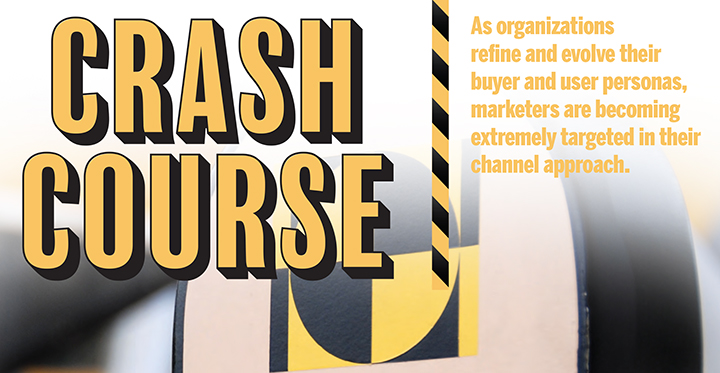Crash Course: Defining Today’s Marketing Vehicles & How They Work For You

Your Marketing Crash Course Here
Written by Michael J. Pallerino
Three marketing experts weigh in on what’s working today and why these vehicles can make a difference in your company:
Marketing automation tools allow for the ability to nurture and qualify prospects and customers with progressive profiling paths that advance a contact through the buyers’ journey with relevant stage-appropriate content, increasing conversion rates.
 Print has become the new “non traditional” marketing strategy, especially on the content marketing side. Print strategies also include techniques such as QR codes and personalized URLs, which help track media crossover. In addition, variable printing continues to allow brands to personalize graphics and images as they are printed. Some brands use it in conjunction with social media campaigns, which encourage subscribers to sign up for free goodies and, on occasion, marketing materials.
Print has become the new “non traditional” marketing strategy, especially on the content marketing side. Print strategies also include techniques such as QR codes and personalized URLs, which help track media crossover. In addition, variable printing continues to allow brands to personalize graphics and images as they are printed. Some brands use it in conjunction with social media campaigns, which encourage subscribers to sign up for free goodies and, on occasion, marketing materials.
Direct Mail
This continues to be used successfully today. According to the “Epsilon Channel Preference Study,” 73 percent of U.S. consumers and 67 percent of Canadian consumers said they preferred direct mail for brand communications, because they could read the information at their convenience. “Because everyone today just emails, using direct mail can be a huge differentiator,” says Michael F. Sciortino, Sr., founder and CEO, Gratitude Marketing. Take oversized postcards, for example. “Find the largest the post office allows (Every Door Direct Mail),” he says. “This will allow you to target specific geographic areas.”
Social
When used in the platform-appropriate context, social provides a great way to stay in front of your audience. By understanding their behavior in relation to the social platform they’re on, marketers are repurposing content into the appropriate format for consumption, increasing conversion rates and acquiring more customers.
“Social media platforms like Facebook, Twitter, Pinterest, Instagram, and Snapchat are leading a new trend of advertising that focuses on creating seamless experiences for their audiences,” says Sean O’Neal, president, Adaptly. “Marketers can now think about how to adapt their campaigns to mimic true consumer conversations. Social platforms offer native solutions that can easily insert brands into real-time conversations, allowing them to capitalize on trending topics.”
Mobile
 This is an emerging best practice that generally is uncharted for most marketing professionals. “Consumer habits and attention spans are changing, allowing for savvy marketers to capitalize on the white space in mobile marketing,” says Randall LaVeau, senior consultant, Sales Benchmark Index. Apps that can provide the greatest value, i.e., time, are providing a captive platform to share messaging and convert opt-in customers and prospects.
This is an emerging best practice that generally is uncharted for most marketing professionals. “Consumer habits and attention spans are changing, allowing for savvy marketers to capitalize on the white space in mobile marketing,” says Randall LaVeau, senior consultant, Sales Benchmark Index. Apps that can provide the greatest value, i.e., time, are providing a captive platform to share messaging and convert opt-in customers and prospects.
Web/Digital
Hyper-personalization is an emerging best practice that has been long used by B2C marketers and is being adapted by B2B marketers. Creating a personalized experience for prospects who return to your website, and the use of ad tracking and retargeting, is becoming more common.
Events
Events have become diluted with poor attempts to convert customers and prospects. For that reason, more companies are finding success with hosted-events that combine current customers and prospects. This approach allows potential buyers to meet customers and share experiences, which helps to speed up sales cycles for new customers and up-sell/cross-sell existing customers.
Stage & Context-Appropriate Marketing
It is vital to be outward in your approach versus inward out. “By doing so, you will always be relevant,” LaVeau says. A great message has the ability to be repurposed and reformatted to match the strength of the vehicle. For example, content on LinkedIn will require a different format and potentially different wording to be relevant and consumed on Twitter,” he says.
Account-Based Marketing
This will make huge strides in the next phase of marketing, because it will be about aligning with sales to engage the accounts that matter most. The legacy approach of high volume top-of-funnel marketing is declining in its effectiveness with organizations whose sales cycles are long, complex, involving many stake holders, departments, and decision makers. Marketers will work closely with sales to focus on account-driven marketing versus contact or individual-driven marketing. Marketers will build a repeatable process to orchestrate personalized marketing and sales efforts to open doors and deepen engagement at specific accounts, LaVeau says.
Sources: Randall LaVeau, senior consultant, Sales Benchmark Index; Michael F. Sciortino, Sr., founder and CEO, Gratitude Marketing; and Sean O’Neal, president, Adaptly
Featured in Connect Magazine, July/August 2016.
Read the full digital version here.

